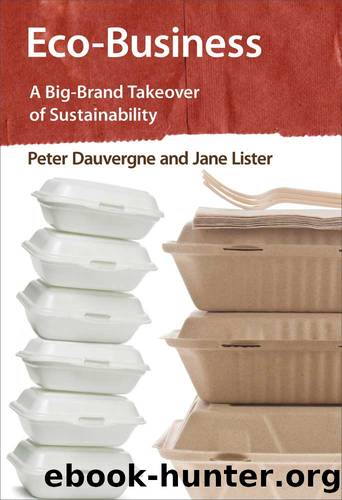Eco-Business by Dauvergne Peter;Lister Jane;

Author:Dauvergne, Peter;Lister, Jane; [Dauvergne, Peter]
Language: eng
Format: epub
ISBN: 3339580
Publisher: MIT Press
Published: 2013-08-15T00:00:00+00:00
Big brands are adopting certification to better control suppliersâ practices and to boost profitability. Chiquitaâs partnership with the Rainforest Alliance in the 1990s to certify their banana crops, for example, introduced new practices to better protect local ecosystems that reportedly also increased farm productivity by 27 percent and reduced costs by 12 percent.17 Big-brand companies are also using certification as a way to establish âgreen credibilityâ and capture the growing demand for environmentally friendly products. The range of certification programs is increasing quickly, and many of these programs include eco-labeling options. To scale up these programs, companies are participating in initiatives (such as the Global Ecolabelling Network) that help to standardize life-cycle analysis methods and metrics and to verify and communicate the eco-friendly aspects of consumer brands.
Governments have well-established green label programs. The European Unionâs standardized Eco-Flower logo and the US ENERGY STAR program are two global leaders. Since 2000 consumers have bought more than 3 billion products with an ENERGY STAR label. The amount of greenhouse-gas emissions avoided in 2010 alone, ENERGY STAR claims, is equal to taking 33 million cars off the road.
Third-party auditing, certification, and eco-labeling programs are not without their challenges and critics (e.g., with respect to consistency and fairness), and challenges and criticisms can present risks to big-brand companies. In response, big brands are launching a growing array of their own logos and labels (some legitimate and some not) to advertise and promote so-called sustainable products. In some cases, this is enabling brands to define and gain market control over the sustainability standards by which consumers will judge their productsâfor example, the definitions and expectations for recyclability, recycled content, organic, carbon neutral, and energy and water efficiency. Some retailers, including Tesco, are planning to go even further, aiming for product labels that will enable consumers to compare things like âcarbon footprintâ as easily as they can compare price or nutritional profile.18
The market, as a consequence, is becoming increasingly crowded with a confusing array of legitimate and illegitimate green claims and labels, which is leaving even loyal eco-brand buyers baffled. Although additional product information improves transparency, it can be difficult to interpret. Specifically, rating the most environmentally friendly product by calculating and weighing the tradeoffs among different attributes can be difficult, as the examples in table 4.2 show.
Download
This site does not store any files on its server. We only index and link to content provided by other sites. Please contact the content providers to delete copyright contents if any and email us, we'll remove relevant links or contents immediately.
The Future of Packaging by Tom Szaky(443)
Rebuilding Earth by Teresa Coady(409)
Hacking Planet Earth by Thomas M. Kostigen(401)
How to Open & Operate a Financially Successful Landscaping, Nursery, or Lawn Service Business by Lynn Wasnak(352)
Hacking Planet Earth: How Geoengineering Can Help Us Reimagine the Future by Thomas M. Kostigen(346)
Making Jeans Green by Paulina Szmydke-Cacciapalle(339)
The Circular Economy by Stahel Walter R.;(338)
A River Runs Again by Meera Subramanian(335)
Social Entrepreneurship and Innovation by Ken Banks(317)
Managing Business Ethics: Making Ethical Decisions by Alfred A. Marcus & Timothy J. Hargrave(303)
Work Like Nature by Lea Elliott(269)
The Clean Energy Age by BF Nagy(249)
Valuing Nature by William Ginn(242)
Strategic Corporate Conservation Planning by Margaret O'Gorman(241)
How to Open and Operate a Financially Successful Landscaping, Nursery, or Lawn Service Business by Lynn Wasnak(223)
When Smoke Ran Like Water: Tales Of Environmental Deception And The Battle Against Pollution by Devra Davis(219)
Exploring Environmental Ethics by Kimberly K. Smith(197)
Turning the Tide on Plastic: How Humanity (And You) Can Make Our Globe Clean Again by Lucy Siegle(177)
The impossibilities of the circular economy : separating aspirations from reality by Harry Lehmann Christoph Hinske Victoire de Margerie and Aneta Slaveikova Nikolova(50)
